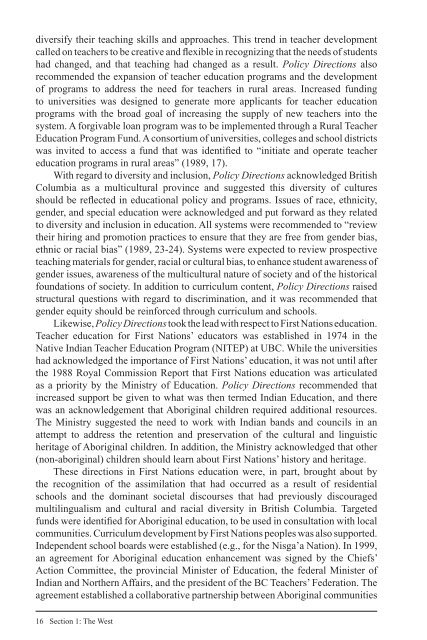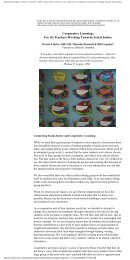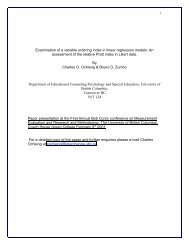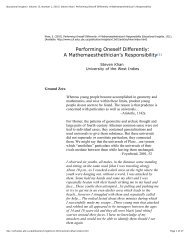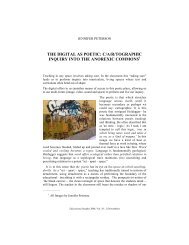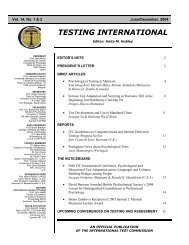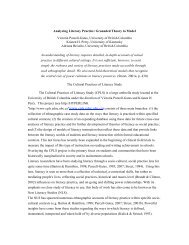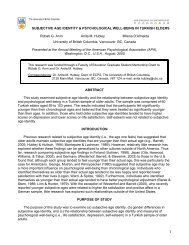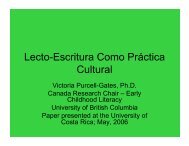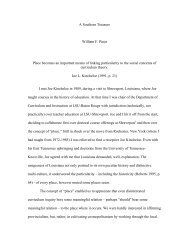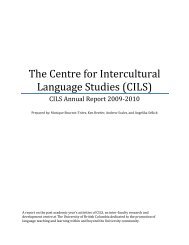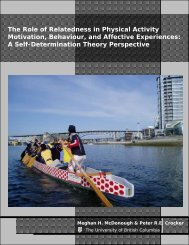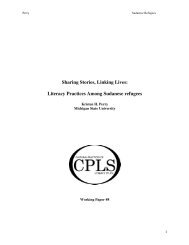The evolution of professionalism - Centre for Policy Studies in ...
The evolution of professionalism - Centre for Policy Studies in ...
The evolution of professionalism - Centre for Policy Studies in ...
Create successful ePaper yourself
Turn your PDF publications into a flip-book with our unique Google optimized e-Paper software.
diversify their teach<strong>in</strong>g skills and approaches. This trend <strong>in</strong> teacher development<br />
called on teachers to be creative and fl exible <strong>in</strong> recogniz<strong>in</strong>g that the needs <strong>of</strong> students<br />
had changed, and that teach<strong>in</strong>g had changed as a result. <strong>Policy</strong> Directions also<br />
recommended the expansion <strong>of</strong> teacher education programs and the development<br />
<strong>of</strong> programs to address the need <strong>for</strong> teachers <strong>in</strong> rural areas. Increased fund<strong>in</strong>g<br />
to universities was designed to generate more applicants <strong>for</strong> teacher education<br />
programs with the broad goal <strong>of</strong> <strong>in</strong>creas<strong>in</strong>g the supply <strong>of</strong> new teachers <strong>in</strong>to the<br />
system. A <strong>for</strong>givable loan program was to be implemented through a Rural Teacher<br />
Education Program Fund. A consortium <strong>of</strong> universities, colleges and school districts<br />
was <strong>in</strong>vited to access a fund that was identifi ed to “<strong>in</strong>itiate and operate teacher<br />
education programs <strong>in</strong> rural areas” (1989, 17).<br />
With regard to diversity and <strong>in</strong>clusion, <strong>Policy</strong> Directions acknowledged British<br />
Columbia as a multicultural prov<strong>in</strong>ce and suggested this diversity <strong>of</strong> cultures<br />
should be refl ected <strong>in</strong> educational policy and programs. Issues <strong>of</strong> race, ethnicity,<br />
gender, and special education were acknowledged and put <strong>for</strong>ward as they related<br />
to diversity and <strong>in</strong>clusion <strong>in</strong> education. All systems were recommended to “review<br />
their hir<strong>in</strong>g and promotion practices to ensure that they are free from gender bias,<br />
ethnic or racial bias” (1989, 23-24). Systems were expected to review prospective<br />
teach<strong>in</strong>g materials <strong>for</strong> gender, racial or cultural bias, to enhance student awareness <strong>of</strong><br />
gender issues, awareness <strong>of</strong> the multicultural nature <strong>of</strong> society and <strong>of</strong> the historical<br />
foundations <strong>of</strong> society. In addition to curriculum content, <strong>Policy</strong> Directions raised<br />
structural questions with regard to discrim<strong>in</strong>ation, and it was recommended that<br />
gender equity should be re<strong>in</strong><strong>for</strong>ced through curriculum and schools.<br />
Likewise, <strong>Policy</strong> Directions took the lead with respect to First Nations education.<br />
Teacher education <strong>for</strong> First Nations’ educators was established <strong>in</strong> 1974 <strong>in</strong> the<br />
Native Indian Teacher Education Program (NITEP) at UBC. While the universities<br />
had acknowledged the importance <strong>of</strong> First Nations’ education, it was not until after<br />
the 1988 Royal Commission Report that First Nations education was articulated<br />
as a priority by the M<strong>in</strong>istry <strong>of</strong> Education. <strong>Policy</strong> Directions recommended that<br />
<strong>in</strong>creased support be given to what was then termed Indian Education, and there<br />
was an acknowledgement that Aborig<strong>in</strong>al children required additional resources.<br />
<strong>The</strong> M<strong>in</strong>istry suggested the need to work with Indian bands and councils <strong>in</strong> an<br />
attempt to address the retention and preservation <strong>of</strong> the cultural and l<strong>in</strong>guistic<br />
heritage <strong>of</strong> Aborig<strong>in</strong>al children. In addition, the M<strong>in</strong>istry acknowledged that other<br />
(non-aborig<strong>in</strong>al) children should learn about First Nations’ history and heritage.<br />
<strong>The</strong>se directions <strong>in</strong> First Nations education were, <strong>in</strong> part, brought about by<br />
the recognition <strong>of</strong> the assimilation that had occurred as a result <strong>of</strong> residential<br />
schools and the dom<strong>in</strong>ant societal discourses that had previously discouraged<br />
multil<strong>in</strong>gualism and cultural and racial diversity <strong>in</strong> British Columbia. Targeted<br />
funds were identifi ed <strong>for</strong> Aborig<strong>in</strong>al education, to be used <strong>in</strong> consultation with local<br />
communities. Curriculum development by First Nations peoples was also supported.<br />
Independent school boards were established (e.g., <strong>for</strong> the Nisga’a Nation). In 1999,<br />
an agreement <strong>for</strong> Aborig<strong>in</strong>al education enhancement was signed by the Chiefs’<br />
Action Committee, the prov<strong>in</strong>cial M<strong>in</strong>ister <strong>of</strong> Education, the federal M<strong>in</strong>ister <strong>of</strong><br />
Indian and Northern Affairs, and the president <strong>of</strong> the BC Teachers’ Federation. <strong>The</strong><br />
agreement established a collaborative partnership between Aborig<strong>in</strong>al communities<br />
16 Section 1: <strong>The</strong> West


